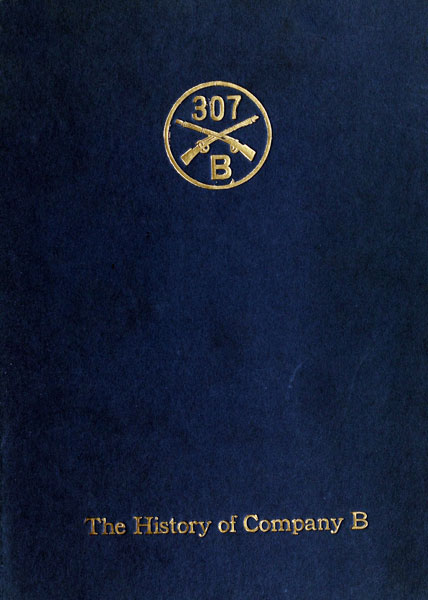
The Project Gutenberg EBook of Company B, 307th Infantry, by Julius Klausner
This eBook is for the use of anyone anywhere at no cost and with
almost no restrictions whatsoever. You may copy it, give it away or
re-use it under the terms of the Project Gutenberg License included
with this eBook or online at www.gutenberg.org
Title: Company B, 307th Infantry
Its history, honor roll, company roster, Sept., 1917, May, 1919
Author: Julius Klausner
Release Date: October 12, 2010 [EBook #33932]
Language: English
Character set encoding: ISO-8859-1
*** START OF THIS PROJECT GUTENBERG EBOOK COMPANY B, 307TH INFANTRY ***
Produced by Patrick Hopkins and the Online Distributed
Proofreading Team at http://www.pgdp.net (This file was
produced from images generously made available by The
Internet Archive/American Libraries.)
• Minor typographical errors have been corrected without note. In all other cases geographical references, spelling, hyphenation, and capitalization have been retained as in the original publication.
• The position of some illustrations has been changed to improve readability.

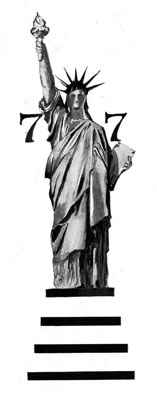
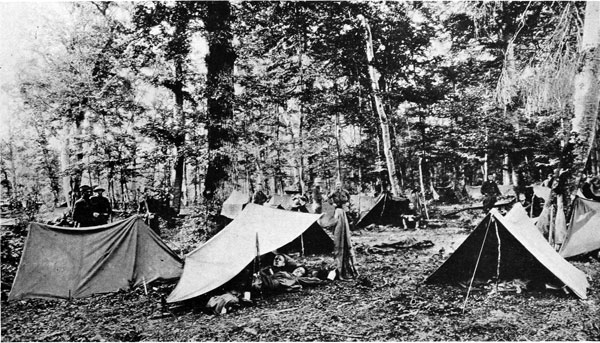 U. S. Official Photo
U. S. Official Photo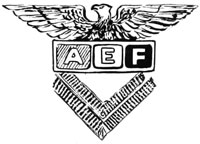
Compiled by
Julius Klausner, Jr.
1920
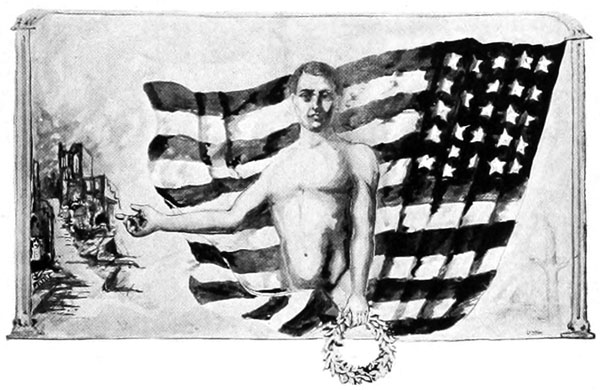 We Who Live Remember—
We Who Live Remember—
And remembering, we shall always seek to justify the self-sacrifice made by those companions who trained with us and fought with us but whom by virtue of their supreme service, we returned without.
They died, but being dead, live on, and their spirits beckon us to strive toward that for which they died.
The flag was their shrine—the fields of France their tomb—and they shall ever be wreathed with God's great glory.
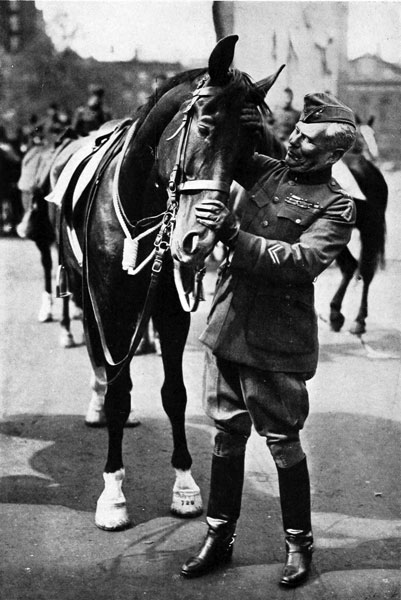 © Underwood & Underwood
© Underwood & UnderwoodGreetings!
I am very glad that Company B—307th Infantry is putting into this form the many memories of the Great War which remain with those of us who participated therein as bright spots in our path through life.
The work done by the 77th Division was most notable and in that work Company B—307th Infantry took full part and contributed its full share. The record of the Company is one of which any organization might well be extremely proud. It took part in the operations in the Vosges; on the line of the Vesle; and in the advance from the Vesle to the Aisne—the 77th Division being the only American division to reach the latter river. In the Argonne-Meuse Offensive which brought the war to a successful conclusion, the Company, with its Regiment, Brigade, and Division, played a noteworthy part. The battle losses incurred by Company B and the battle honors conferred upon members thereof speak for themselves.
Not the least of the Company's exploits was that which, culminating on the evening of October 7th, 1918, brought relief to the long-beleaguered Battalion under the command of Lieutenant-Colonel Charles W. Whittlesey—the so-called "Lost" Battalion.
The officer to whom was granted the supreme honor of sharing with you as your Divisional Commander the toils, the dangers, and the honors of that supreme campaign salutes you! No Commander could ask more loyal support from his comrades of all ranks than was freely given me. For your future careers in civil life or wherever Fortune may lay your paths, you will carry with you my sincere best wishes and my affectionate regard. The qualities of courage, fidelity, and loyalty displayed by you during your service as soldiers will be, I am sure, at the disposal of your Country as well in Peace as they were in War.

November 19th, 1919.
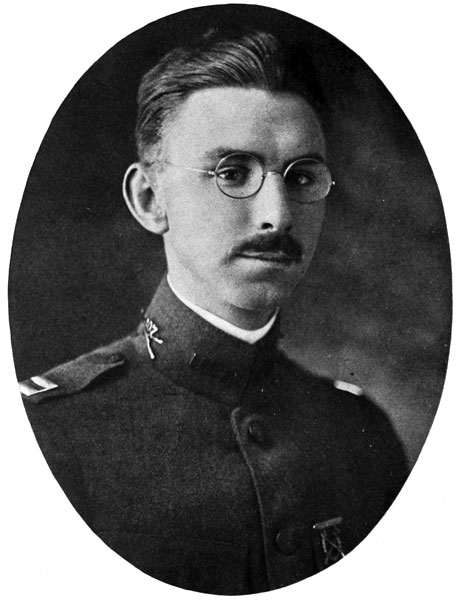 Captain Blanton Barrett
Captain Blanton Barrett NVITED—all of us. And we trooped down Yaphank-way, out
on Long Island, as tho bound for a picnic. Which, for a week, it was.
Then we were brought up short. On September 17, 1917, the 77th Division
came to life. One of the first units to be organized within the division
was Company B—307th Infantry, formed also on September 17th.
NVITED—all of us. And we trooped down Yaphank-way, out
on Long Island, as tho bound for a picnic. Which, for a week, it was.
Then we were brought up short. On September 17, 1917, the 77th Division
came to life. One of the first units to be organized within the division
was Company B—307th Infantry, formed also on September 17th.
Immediately we were on paper as a regular unit, we quickly took semblance of a military organization. Under the leadership of Captain Blanton Barrett, 1st Lieutenant Alexander D. B. Pratt, and 2d Lieutenants Philip Cheney and Everett A. Butterfield, we were gradually whipped into an efficient machine. Corporals were made and unmade—sergeants came and went—and we were drilled, drilled, drilled.
We had exchanged our hair mattresses for straw, our china for tin, our homes for barracks, and they made us like it. At first we occupied but one building,—a rambling two-story affair having bunk rooms on all the upper floor. The lower floor was given over to kitchen, mess hall, and recreation room. The recreation room, however, was short lived, for as we grew in numbers it became necessary to fill it with bunks. And then, when we had grown to full strength—two hundred and fifty officers and men—we overflowed into another barracks of which we occupied half of both upper and lower floors.
The advantages of a billiard table, a piano, and a talking machine were ours. We supported a miniature barber shop and a tailor. Talent we had a-plenty, and we ran our own shows.
But we drilled, drilled, drilled. And we had schools—lots of 'em. When we were not doing the "school of the soldier", we attended bayonet school. The "school of the squad" divided time with gas instruction. The study of the automatic rifle was complicated, but so was the "school of the platoon". We practiced the manual of arms and learned how to throw hand grenades. Little by little we were perfected in the art of thinking, and knowing, and doing, the right thing at the right time.[Pg 10]
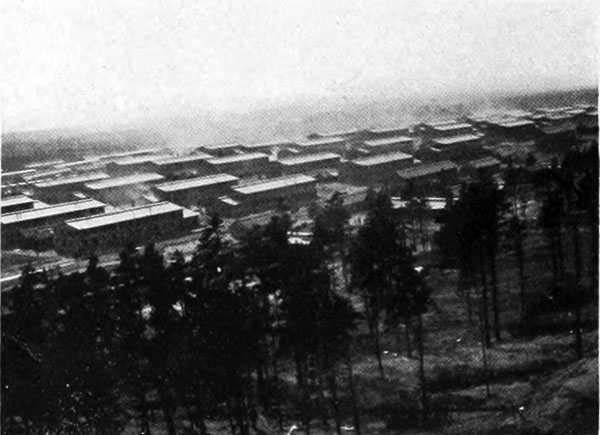 Camp Upton, New York. Bird's-eye View from Tower Hill
Camp Upton, New York. Bird's-eye View from Tower Hill
Early in 1918 we felt ready. On Washington's Birthday our division paraded down Fifth Avenue a complete fighting machine. We were prepared for the next move and the cheers of the crowds had barely died when it came.
On the night of April 5th we were ordered to roll packs. We stacked our bunks and drew ammunition. And we were posted on a vigil of waiting. April 6th, 1918, Saturday, was the first anniversary of America's declaration of war. At two-thirty on that morning, in an air pleasantly crisp and flooded with moonlight, we marched to the railroad and entrained. Leaving Camp Upton at three-fifteen, we pulled into Long Island City just in time to be greeted by the usual six o'clock factory whistles.
A waiting ferry engulfed our battalion and we were transported down the East River, around the Battery, and up the Hudson to Pier 59, at the foot of West Eighteenth Street, Manhattan. A methodical transfer was accomplished from the squat and stunted ferry to the gigantic but little known Justicia.
While still under process of construction in the shipyards at Belfast, in Ireland, for the Holland American Line, the Statendam was commandeered by Great Britain at the beginning of the European war and was operated as a transport under the name Justicia by the White Star Line. She was at the time the fifth largest vessel afloat and that she was the especial prey of the German undersea navy is indicated by the fact that a submarine attacked her on a subsequent trip from England to the United States, on July 20th, and after a dramatic engagement lasting some twenty-four hours, she was sunk. Fourteen of a crew of seven hundred were lost.
All day men and equipment poured onto the decks and into the hold of the giant transport. Our entire regiment and one battalion of the 308th Infantry were quartered between decks. Next morning, before reveille, the Justicia slipped quietly down New York Bay, thru Ambrose Channel, and into the Atlantic.
B Company had no quarters de luxe. We were crowded into small space—Section K—far down on D deck, with sleeping hammocks slung over our mess tables. And our mess, served by the British, was a sorry series of meals. We were compelled to wear during the day, and to sleep with during the night, ungainly life preservers. But discomforts were subordinated to the interest in our new surroundings. The mysteries of the big ship, its spotless engine-room, the intricacies of navigation, the precautions against possible attack,—all held us.[Pg 11]
On leaving New York we pursued a northerly course, and at nine o'clock that night anchor was dropped in lower Bedford Bay, at Halifax. Early next morning we steamed up into the inner harbor and before us lay the sadly devastated city of Halifax. Immense areas of the city had been totally destroyed by the explosion resulting from the collision between a Belgian relief ship and one bearing a cargo of explosives.
That day and the next, while waiting for our convoy to assemble, was spent in practicing with lowered boats.
Late on the afternoon of April 9th our convoy of ten passenger and cargo ships passed out of the harbor, sped by the cheers of the crews of two American battleships. We were escorted by U. S. S. St. Louis and H. M. S. Victoria.
Boat drill, a well-ordered scramble for life boats, took place twice daily. Each morning we indulged in strenuous setting-up exercises in order that we might remain in trim. Practice with depth bombs and smoke screens helped to relieve the tedium of the long trip.
As we neared our unknown destination, our escort was increased by ten British torpedo boat destroyers. Veritable sea dogs they were, darting every which-way, breasting wave after wave, ever watchful for the tricky Hun.
And then, on Friday. April 19th, land! Just a ridge above the horizon—the blue hills of Wales—but already we could feel in our imaginations the solidity which our unsailorly legs had missed.
As the day waned we sighted the lighthouse at the mouth of the River Mersey. With cheers of relief we were permitted to doff our bulky life belts. Just before dusk we entered the Mersey, passing closely by the beautiful seaside resort of New Brighton.
Forging up the river we reached Liverpool and, at nine o'clock that evening, after almost fourteen days afloat, our transport was moored. The city, as we saw it from the decks of the Justicia, lay quietly, with lights beginning to twinkle in the increasing gloom.
One by one the companies formed and debarked, and at 11:15 P.M. B Company marched down the gang plank, thru half-lighted sheds, into those curious side-door railway cars so peculiar to Europe. Exactly at midnight our train pulled out of Liverpool. At 3:00 A.M. a short stop for hot coffee was made at Rugby. We passed thru the outskirts of London at 6:00 A.M. and at nine-twenty the train rolled into the terminal at Dover.
The private yacht of Belgium's Queen Elizabeth had been pressed into service as a cross-channel ferry and in this royal craft, under escort of destroyers, aeroplanes, and dirigibles, we crossed to Calais in an hour and thirty-five minutes. The crossing was enlivened when two riflemen of the crew took to firing at mines that endangered our passage.[Pg 12]
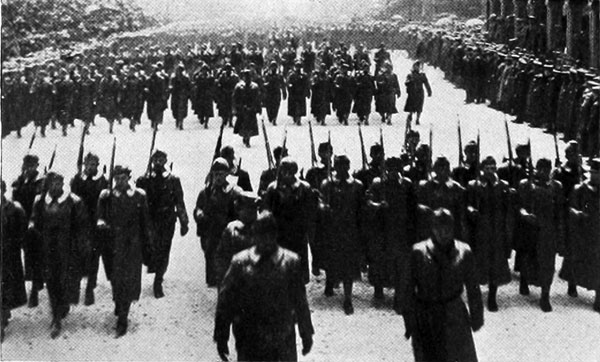 © Underwood & Underwood
© Underwood & UnderwoodOnce in Calais we found that we divided honors with Company C of our regiment in being the first two National Army companies to land in France, having debarked on French soil April 20, 1918.
That night we experienced our first real touch of war. Sheltered in tents in British Rest Camp No. 6, we received a call of welcome from a squadron of Jerry aeroplanes. A truly thrilling reception it was, with the thunder of Hun bombs alternating with the "ping!" of British anti-aircraft guns,—and thru it all the "pat-pat" of a multitude of machine guns. But best of all, there were no casualties.
Next day we spent in adding to our equipment gas masks and trench helmets and we exchanged our American Enfield rifles for British Enfields,—lighter, shorter pieces having a magazine capacity of ten rounds of ammunition.
April 23d introduced us to the famous little "40 hommes—8 chevaux" box-cars of the French. A three-hour journey in these brought us to the British base at Audruicq. Our first real hike started from here and ended at Zouafques, a little village in Picardy. We occupied some of the best sheep-pens, cattle stalls, and hen roosts in town and during our five-week stay we became really comfortable inhabitants.
Zouafques proved to be a sort of military high school, where we polished our elementary knowledge of tactics. Our "noncoms" were sent to specialized schools in scouting, sniping, musketry, automatic rifles, grenades, and infantry tactics. The instruction, as well as the food and equipment, was distinctly British.
Five weeks of this work and we took our next step trench-ward. Hiking from Zouafques at 1.30 A.M., May 13th, we entrained a la chevaux at Audruicq. A day's journey via Calais, Boulogne, Etaps, and Doullens brought us to Mondrecourt, in Flanders. Then an almost heartbreaking hike thru Pas to the war-worn village of Couin.
Our assimilation by the British forces became most complete when we found ourselves brigaded with a battalion of the Lancashire Fusileers of the 125th British Brigade. Our position was in reserve of the British lines north of Amiens and southwest of Arras.
Here another five weeks of training gave us the right to work alone. Once again we traded rifles, retrieving our American guns, and on June 6th we started on a three-day march. Thru Gézaincourt, Bernaville, Ailly le-Haut Clocher, to Pont Remy, where we entrained.[Pg 13]
Two days by rail, via Amiens, Versailles, Bar-le-Duc, and Nancy, and we detrained on June 11th at Thaon, in the Vosges. Then an intermittent hike, with stops at Longchamps, Destord, and Menil, passing thru Rambervillers and Baccarat, to Vacqueville, in the Lorraine.
A stirring incident occurred en route when we passed the boys of the old Sixty-Ninth New York Regiment. Brooklyn hailed Brooklyn; Harlem called to Harlem; Bronx met Bronx. It was a breath of home to the already veteran Sixty-Ninth and more than a cheering welcome to us.
We shared Vacqueville with a battalion of the Alabama regiment of the 42d "Rainbow" Division. Advance parties were sent into the lines to acquaint themselves with the position which we were to take over. And in the dead of night, on June 20th-21st, Company B took over that part of the line between Ancerviller and Badonviller designated as P. C. (post commandant) Hameau and P. C. Montreux.
The first and second platoons of our Company held a position in the Grand Bois (Big Woods), a section of forest southeast of Ancerviller. The second and third platoons and Company headquarters occupied the ruined village of St. Maurice. St. Maurice was a part of the line at this point and had been subjected at different times to severe shelling. Only bare skeletons of the buildings remained and any nook or cranny between sections of walls and under a bit of roof was used as shelter. Deserted cellars had been bolstered, reinforced, and barricaded so that they would serve as shell-proof protection in the event of attack.
It was usually Fritz's intention to place a harassing barrage on any section of the line where he knew that a relief was being effected. But he was less watchful than usual when we went in.
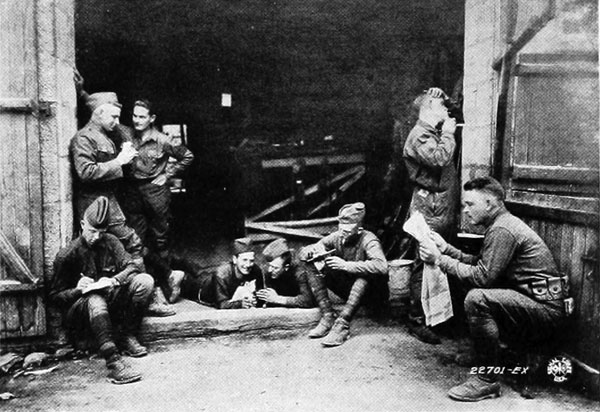 U. S. Official Photo
"Hotel de Barn"—Showing Barber Shop and Reading and Writing Rooms
U. S. Official Photo
"Hotel de Barn"—Showing Barber Shop and Reading and Writing Rooms
The enemy awoke, however, three days later, on the morning of Monday, June 24th, and attacked our regimental outposts. In order to effectively prevent any assistance being rendered by the platoons stationed in St. Maurice, a heavy barrage was laid on the town beginning at 3:30 A.M. During the early part of the shell[Pg 14]ing the continual use of H. E.'s (high explosive shells), with an occasional gas shell, served to keep the men not only penned in their bomb-proof cellars, but also forced the continued use of gas masks. Gradually the H. E.'s were interspersed with gas shells until a point was reached where far more gas shells than high explosives fell into the town, resulting in a heavy blanket of phosgene, mustard, and lachrymatory gases settling over the position.
The barrage did not lift until 6:00 A.M. and when it did the platoons were forced to take a defensive position to guard against any possible success of the enemy.
During the night before the attack, the men had been digging until a late hour on a system of trench defense. This entailed a lack of sleep which, together with the continued wearing of the gas mask and the exposure endured immediately after the barrage, weakened their resistance to such an extent as to make them easy victims to the poisonous gases.
Seventy-nine men were forced to the hospital by the effects of the combined phosgene and mustard. Among them were our first sergeant, supply and mess sergeants, all but one of our cooks, and both mechanics, which left us decidedly crippled.
The shadow of our losses was deepened when we heard that Cook George Alberts, always popular, had died from gas inhaled while trying to prepare the company breakfast in a gas-filled kitchen. He was our first loss by death.
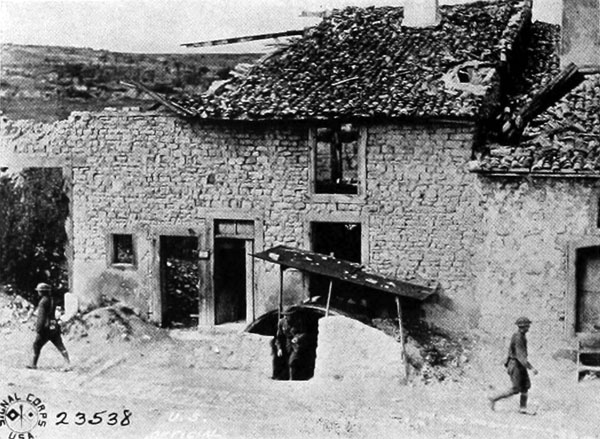 U. S. Official Photo
U. S. Official PhotoAn immediate result of our losses was the extra work shouldered by those who had escaped any of the serious effects. The men left in St. Maurice remained on constant guard until the Company was relieved several days later.
During the short rest period that followed, a reorganization of the Company was accomplished and we again entered the lines in July, taking over P. C.'s Hameau and Montreux, as before.
On Sunday, July 21st, a patrol of fifty-two men from our Company, accompanied by two medical first-aid men, engaged in a raid on the German trenches at two-thirty in the afternoon. The party advanced on the enemy lines in single[Pg 15] file, divided in four groups which were respectively commanded by Sergeant Todd, Captain Barrett, Sergeant Bromback and Lieutenant Mohlke.
The intent was to surprise the enemy with a daylight raid and thereby obtain information thru capture and observation. But either thru knowledge or by chance, the Germans had prepared against this maneuver and the surprise was reversed.
Waiting until our patrol was fairly within their lines, and then partially surrounding them, the enemy centered upon our men a deadly fire of rifles, machine guns, and grenades. The raiders fought valiantly in return but were outnumbered four to one. After an hour's fighting, seventeen of our party, including Captain Barrett, lay dead, and sixteen were captured. Of the twenty-one who returned, thirteen were wounded. We were informed by two German prisoners captured a few days later that seventeen Germans had been killed.
The loss sustained in this daylight raid occasioned considerable comment, chiefly because it was generally believed that Captain Barrett had misread his orders,—that the time for action had really read 2:30 A.M. instead of 2:30 P.M. This, however, is quite untrue, inasmuch as all the Company officers, as well as the supply sergeant and company clerk, were conversant with the orders. Captain Barrett's immediate battalion and regimental superiors were present at or near the time of action and possessed full knowledge of the entire plan.
The defeat was caused solely by the lack of the intended element of surprise. Whether or not the enemy had possession of our plans, and if they had possession, how they obtained it, is something we shall never know.
A telegram was received by the Divisional Commander from General Headquarters to the effect that the entire action had been investigated and found creditable.
The casualties suffered from the raid, together with those resulting from the gas attack of June 24th, so depleted the Company as to make an immediate relief imperative and that same night Company L took over our sector.
A subsequent reorganization of the entire regiment distributed the men of the various companies so that all would have an equal strength. Our numbers were so few that we lost none of our men in this process but instead received increases not only from many of the other companies, but also from the 76th New England Division.
As tribute to those men whom we had lost, a Company B mass was held at the Catholic Church in Vacqueville at which[Pg 16] Chaplain Father Walsh of our battalion officiated. The entire strength of the Company was present.
Another rest and another turn up front, after which the entire division was relieved by the 37th Ohio and Kentucky Division. Once again we crossed the Vosges, halting for three days at Seranville. Leaving there, we bivouaced for a night in the Forêt de Charmes and entrained at Charmes next morning, August 7th, at dawn.
Two days later, August 10th, we took transport on an immense train of motor trucks—"lorries" we called them, after the English. They were driven by Indo-Chinese serving under the French. After nine cramped but interesting hours—we passed thru Chateau-Thierry—our trip ended at Fere en Tardenois. For three days we camped in a small wood and then we moved to a position supporting the attack on Fismes. We were stationed in the Bois de la Pissotti, adjoining the Forêt de Nesle. While there we were engaged in digging a series of reserve trenches near Mont-sur-Courville.
On August 28th the battalion moved around Chéry-Chartreuve to a position east of Le Prés Farm. September 1st we again shifted, this time crossing the Vesle and relieving the Third Battalion, just east of Bazoches. Here we repulsed a raiding party, inflicting heavy losses upon the enemy. We were then moved to a ravine, which gave us the opportunity of taking a two-day rest.
Our next move brought us to face with the enemy just south of Merval, where we took a position in an exposed field, our only protection being the individual "funk holes" which had been deserted by the retreating German troops.
After three days of little water and practically no food, at 5:30 on the afternoon of September 8th—still brilliant daylight—we crawled from our funk holes and, each squad in single file in formation known as "squad columns", we advanced against German artillery in an effort to straighten the line. As we reached the outskirts of Merval we were subjected to an intense barrage of H. E.'s, suffering the loss of four men killed and five injured.[Pg 17]
No gain was made by this sortie and we drew back to our funk-hole position awaiting further developments.
Early on the morning of September 14th, supported by a barrage laid down by combined American, French, and Italian artillery, we attacked the enemy position that lay on the far side of the Ravine Merval.
The advance was made down the side of the valley in the face of a withering fire of enemy machine guns. Tho suffering heavy casualties, our progress was unchecked and we swarmed up the opposite slope with undiminished vigor. So rapid were our gains that we had to pause to allow our flanks to catch up. Our Third Platoon was so far ahead of the line of advance as to be mistaken by the commander of the cooperating French forces for a body of the enemy and it required considerable persuasion to correct his misconception. The day's end saw the German horde driven across the Aisne, and we were well beyond our original objective. But we had advanced true to form. Commenting on a previous attack made by another American unit, a French officer had remarked: "The Americans,—they are fools. Tell them to take one trench,—and they take three!"
We had been operating on the line of the Vesle with several divisions but the 77th was the only American division to drive its way to the Aisne.
Our gains were paid for with numerous casualties and when we received our relief it was thoroly welcome. It had been our longest consecutive stretch in the front line and we suffered not only from battle losses but we had also endured the utmost privation. Short rations, little water, exposed positions, and the constant necessity for watchfulness had undermined our strength to an unusual degree. We had been operating on the will to accomplish rather than on food and water.
An Italian unit relieved our Company and we withdrew to a reserve position in the Vesle Valley, east of Fismes. Here, on the night of[Pg 18] September 16th, our division was relieved by an Italian division and we pulled out of the sector.
We looked forward to a period of rest, but it was not to be. Twenty kilometres of hiking brought us to the Arcis le Ponsart Forest, where we bivouaced for a day. Then into lorries for an all-night ride to Le Chatelier-sur-Marne, where our losses were replaced by a detachment from the 40th "Sunshine" Division. Two days of speculating as to our chances for a rest terminated when on the night of September 20th we were ordered to roll packs. We stepped off on a thirty-two kilometre hike at 1:00 A.M., via St. Menehould and Florent, and seventeen hours later we dragged ourselves into the Forêt de Maisons Petites where we were quartered in barracks at the edge of the Argonne Forest.
The memorable and decisive drive known as the Argonne-Meuse Offensive started on September 26th. That day found us entrenched near the main road at Florent,—a position in reserve of the 1st Army Corps.
Actual operations were started that night, when the entire cannon of half a hundred divisions poured forth on the enemy its scorching fire. Next morning we moved to a position north of Florent, and three days later we moved thru the town of Le Four de Paris into those trenches north of La Harazee that had been deserted by the 122d German Regiment of the 2d Landwehr Division.
October 2d we left the reserve and assumed a support position. On that day the forces in the line drove forward, but in the execution of the advance Companies E, H, I, K, L, and M of the 308th Infantry and Company K of the 307th Infantry found themselves trapped by the enemy on a hill north of the Bois de la Buironne. These units were the only ones to reach their objective but by thus advancing ahead of their flanks, they gave the enemy an opportunity to surround them. In this hazardous position they struggled as the "Lost" Battalion.[Pg 19]
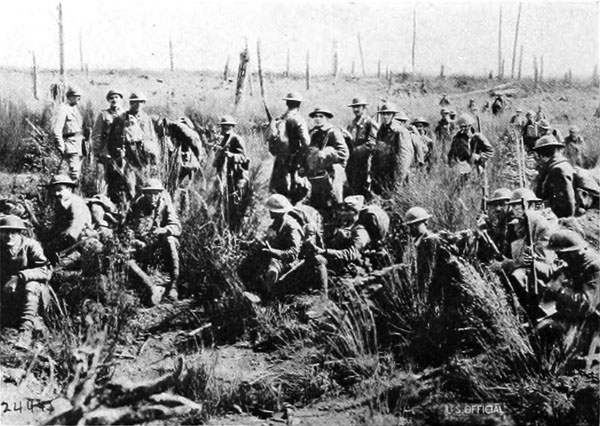 U. S. Official Photo
U. S. Official PhotoWe went forward to their relief on October 4th, but were held back by the effective machine-gun fire of the enemy. Next day we again strove to extricate the besieged battalion, but again we failed. Certain enemy machine guns were so placed that their hail of death was impassable. They seemed an insurmountable obstacle in the path of the entire 307th Infantry. The men of Company B knew that the machine-gun positions of the enemy must be taken. There was nothing, at that moment, that counted more than the capture of these positions. So on October 6th we attacked, giving no thought to risk. We did what we thought would have been impossible before we knew that it had to be done. Persistently we attacked in the face of the enemy fire and as the German resistance gradually weakened, we took the heretofore impregnable positions. Seven of our men were that day cited for exceptional bravery.
On October 7th our division organized a concerted attack on the German lines. We realized the awful plight of the "Lost" Battalion and all day we fought against the enemy machine-gun nests. One by one they were silenced, and at 5:00 P.M. Company B, alone of all the division, succeeded in reaching and saving the "Lost" Battalion. The Germans were driven beyond the hill and once more the line was straightened out.
Another week and we had driven the Germans across the River Aire. We remained in a clump of woods until October 16th and then, not even waiting for our engineers to throw their bridges across the Aire, we waded the river and drove against Grand-Pre, which was the keystone of the enemy defense in the sector opposed by our division.
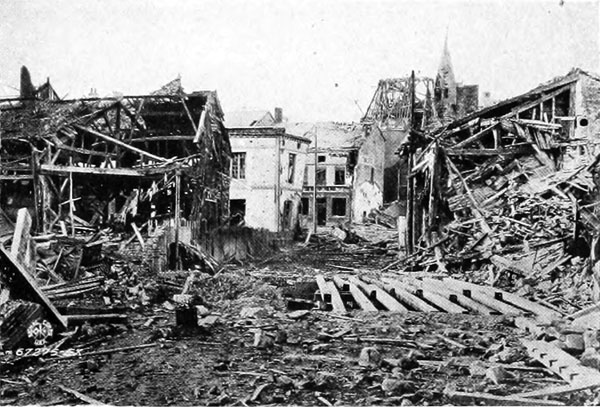 U. S. Official Photo
U. S. Official PhotoWe were stubbornly opposed by the 253d German Infantry of the 76th Reserve Division. Again and again we assaulted the position and finally, after a running fight thru the streets, the town was ours and the American wedge was in a fair way to split the entire German defense.
We pulled out of the line on October 17th and withdrew 10 kilometres to a small forest near Apremont, being relieved by the 78th New Jersey Division. As usual, there was no rest, and on October 21st we moved to Fleville for a three-[Pg 20]day stretch of trench digging. October 31st was spent in digging trenches in the Chattel Valley.
We resumed our activities at the front on November 2d, keeping in mind that half injunction, half promise, credited to General Pershing: "Hell, Heaven, or Hoboken by Christmas!" We gave little thought to Heaven and less to Hell but, we were beginning to long for Hoboken, and we went forward with irresistible determination. Hiking via St. Juvin to Thenorgues, we loaded into motor trucks. Unloading close to the lines, we swung into immediate action and on November 3d we wrested the village of Fontenoy from the 45th German Reserve Division, the following day capturing the village of Oches from the 76th German Reserve Division.
Stonne, a village of strategical importance, was next selected by the enemy as a point of resistance. On November 5th the combined strength of our entire Regiment was hurled against the 195th German Division, and Stonne fell to us. The capture succeeded in liberating a French population that for four years had been under the dominance of an enemy army.
The enemy by this time was retreating fast, and so closely did we press them, we were far in advance of our cannon. The progress of the big guns was much delayed by poor roads, but the spirit of victors was in us all and little did we miss our artillery.
In quick succession we took town after town, the enemy losing to us in one day,—November 6th,—the villages of Raucourt, Haraucourt, Angecourt, and Remilly. The terror-stricken Hun gave little resistance and we kept within five minutes of their rear guard.
We came to a halt on the banks of the Meuse, four miles from the historic city of Sedan and, after augmenting our depleted ranks by replacement from the 38th "Cyclone" Division, we organized for what we hoped would be our final attack.
But the final attack had already been made. The unconquerable Argonne had been conquered; a ruthless enemy was vanquished.
Germany sued for Peace with defeat rather than face peace with Death. The last shot was fired at the Eleventh Hour of the Eleventh Day of the Eleventh Month, Nineteen Eighteen, and we rested on our arms worn and tired, but victorious and happy.[Pg 21]
The joy of accomplishment was ours and we celebrated the declaration of the armistice in a spirit far more triumphant than relieved.
On November 12th the same French who had laughed at us in pity as we shouldered their task in the Argonne, hailed us with gratitude as they took over our positions.
The march from the Meuse to our rest base in the Chateauvillain area took twenty-four days and covered 300 kilometres. It was an intermittent hike and we stopped successively at La Berliere, Oches, Harricourt, Fleville, Le Four de Paris, Florent, Sivry-sur-Ante, Noyers, Andernay, Hoericourt, Eclaron, Fresnay, Maisons, and Bayel, arriving at our base in Lanty on December 5th.
It was soon apparent that altho we had been spared the alternatives we still were not going to see Hoboken before Christmas. So we made ourselves comfortable and settled down to a long stay.
It was necessary to the maintenance of discipline and the morale of the army that drills should be continued, and as well as any recruit, we were once again schooled in the finesse of the salute, the art of the right face, and the strategy of shoulder arms. We engaged in manouvers to practice the lessons that we learned in the Argonne. And we passed in reviews before princes, generals, and congressmen. Time passed: not too quickly, but still it passed.
Christmas was not the dreary day a Christmas away from home usually is. We had much for which to be thankful, and the intervening miles between Lanty and Home were no bar to those good wishes that came from our folks.
We celebrated, we ate, and we played Santa Claus. A tree was erected in the centre of the village and we passed out to the civilian population candy and biscuits and tobacco. The women and children and men sincerely appreciated our tokens, and happiness reigned.
The mess sergeant had an inspiration of genius and he served us with a truly Christmas dinner.
New Year's Day was red-lettered with another meal worthy of our mess sergeant's reputation. The holiday season was over and we entered upon the new year full of new hopes and ambitions.
Not until February 9th was another move made. Then, en freight car, we journeyed to the Le Mans area, detraining at Poillé from whence we hiked to La Roches Farm, near Auvers-le-Hamon. April 15th we entrained at Sable for Brest, where we were quartered at Camp Pontazaine.
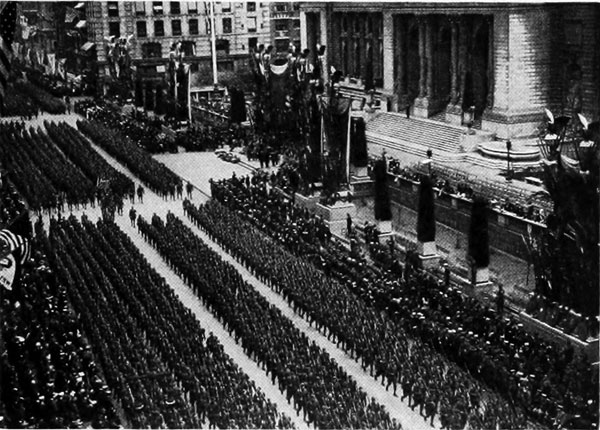 © Underwood & Underwood
© Underwood & UnderwoodOn April 19th, exactly one year after our arrival at Liverpool, we were lightered out to the United States Transport America.
A fast ship and smooth waters combined to give us a rapid and enjoyable voyage and we docked at Hoboken at 9:00 A.M., April 28th. We proceeded to Camp Mills, Mineola, Long Island, where immediate passes gave us the opportunity to greet our home folks, eat home meals, and sleep in regular beds.
The Company moved on May 5th to the armory of the 22d New York Engineers in New York City to await final orders for the parade of welcome arranged by New York City.
We formed for the parade near Washington Square at 8:00 A.M. next morning and at 10:00 A.M. we marched out to Fifth Avenue and swept up that thorofare to the acclaim of a million throats. No greeting could have been more sincere, no welcome more impressive, and this, our last hike as Company B, was a march of glory.
We returned to Camp Upton, our first station and our last, and we were demobilized on May 9th, 1919, to return to our respective states. Ours was a truly American company, composed of true and representative Americans. Our homes lay in thirty-two different states, scattered between New York and Maine in the east, Minnesota and the Dakotas in the north, Utah, Oregon, and California in the west, and Texas, Louisiana, and Florida in the south.
So ends the History of Company B. We were mustered out of the service
military, but the spirit that withstood the Lorraine, the valor that
gained the Aisne, and the fire that conquered the Argonne, lives on, and
we have banded ourselves together so that we may, in the words of our
commander, Major General Robert Alexander, "serve our Country as well in
Peace as we did in War".

| Major Weston C. Jenkins, D. S. C. | 208 West Thomas St., Rome, N. Y. |
| Major Fred A. Tillman, Legion of Honor | 19 Commercial St., Boston, Mass. |
| Captain Blanton Barrett, DECEASED | Chamblee, Georgia. |
| *Captain Everett A. Butterfield, Black Star | Lambs' Club, New York. |
| Captain Philip Cheney | South Manchester, Connecticut. |
| Captain Alexander D. B. Pratt | 120 Broadway, New York. |
| Captain Alonzo D. Slagle | Address unknown. |
| Captain Howard S. Smith | New Haven, Connecticut. |
| 1st Lieutenant Joseph D. M. Adrian, Jr. | 50 Broad St., New York. |
| 1st Lieutenant Marcus L. Chasins | 27 William St., New York. |
| 1st Lieutenant Alexander J. Gillespie | 251 West 81st St., New York. |
| 1st Lieutenant Kenneth C. Lincoln | 29 Bedford St., Fall River, Mass. |
| 1st Lieutenant George S. Mott | Scranton, Pennsylvania. |
| 1st Lieutenant William R. Reid, D. S. C., DECEASED | Brooklyn, New York. |
| 1st Lieutenant Harry R. Weiman | St. Louis, Missouri. |
| 2d Lieutenant Atwood | New York City. |
| 2d Lieutenant William Eliot | Long Island City, New York. |
| 2d Lieutenant Clarence I. Grubbs, DECEASED | Kansas City, Missouri. |
| 2d Lieutenant Foster A. Gunn | Main St., Ottawa, Kan. |
| 2d Lieutenant Arthur J. Hamblen | 150 West 106th St., New York. |
| 2d Lieutenant F. Hartig | Address unknown. |
| 2d Lieutenant Hardon | Yale Club, New York. |
| 2d Lieutenant Harrison McCann | 2156 Cortelyou Road, Brooklyn, N. Y. |
| 2d Lieutenant George C. Mohlke | 816 Grand Ave., Racine, Wis. |
| 2d Lieutenant O'Connell, DECEASED | New York City. |
| 2d Lieutenant Thomas O'Sullivan | New York City. |
| 2d Lieutenant William Randall | New York City. |
| 2d Lieutenant James Schofield | 88 Main St., North Andover, Mass. |
| 2d Lieutenant Austin W. Woolford | Virginia. |
| *1st Lieutenant William F. Babor | 417 East 75th St., New York. |
| *1st Lieutenant Arthur D. Bromback | 41 Division St., New Rochelle, N. Y. |
| *1st Lieutenant Raymond S. Hill | East St. Louis, Illinois. |
| *1st Lieutenant Euclid L. Levasseur | Farmers Loan & Trust Co., Paris, Fr. |
| *2d Lieutenant Herbert H. Harris | 1445 Broadway, New York. |
| *2d Lieutenant Arthur S. Hoit | 71 Broadway, New York. |
| *2d Lieutenant Paul F. Hunnewell | 287 Main St., Winthrop, Mass. |
| *2d Lieutenant Louis Katz | New York City. |
| *2d Lieutenant W. Alan Mathews, DECEASED | Pittsburgh, Pennsylvania. |
| *2d Lieutenant David H. Rose | 915 Intervale Ave., New York. |
| *2d Lieutenant Edgar L. Schwartz | 10 West 93rd St., New York. |
The officers before whose names has been placed an asterisk (*) were commissioned from the enlisted ranks of Company B and assigned to duty with other organizations.
Elwin Abbott, 188 Crescent St., Rutland, Vt.
Samuel Abrahamson, Nicolet, Minn.
Clarence R. Ackerly, 624 Broad St., Bridgeport, Conn.
Allan Adams, 68 West 102d St., New York.
James Adams, 107 West 89th St., New York.
Adolph Albrecht, 190 East 3d St., New York.
Carl Aldridge, Glen Allen, Ala.
Fred Alexander, Carterville, Ill.
M. Alpert, Watertown, N. Y.
Machis Ambrogio, 412 N. 21st St., Herrin, Ill.
Lloyd C. Anderson, Binghamton, N. Y.
Robert Angeles, Route 2, Bethpage, Tenn.
Paul Annello, Box 19, Bristol, Conn.
Hugo Antonelli, 732 Nostrand Ave., Bklyn, N. Y.
Paul Antonelli, 732 Nostrand Ave., Bklyn, N. Y.
Nathan Aronson, 26 Norman St., Salem, Mass.
Isaac Ascher, 111 Haverschoff St., Boston.
Elmer O. Barber, Hillsboro, Ore.
Luke M. Barendsen, Valier, Vt.
Robert Barr, 108 West 49th St., New York.
John Barry, Newburgh, N. Y.
Harry Bartlett, Mendon, Utah.
Fred C. Batchellor, 260 Laurel St., Hartford, Conn.
Thomas Baxter, 604 N. Maine St., Butte, Mont.
Herman Beck, 84 Rivington St., New York.
Louis Beckendorf, Brooklyn, N. Y.
William Bell, 158 East 107th St., New York.
Earl D. Bement, Route 3, Sioux Falls, S. D.
David Bennett, 438 52d St., Brooklyn, N. Y.
Thomas Bennett, Seymour, Conn.
Fred Berge, Bismarck, N. D.
Edward Bolma, Hill, Mont.
Paul D. Bond, 208 Cedar Ave., Richmond Hill, N. Y.
J. A. Boyle, Long Island City, N. Y.
Leslie Bradney, Pangborn, Ark.
Charles H. Bradshaw, 179 Bainbridge St., Brooklyn, N. Y.
Michael Bresnan, 95 Myrtle Ave., Ansonia, Conn.
Ralph U. Brett, 701 West 178th St., New York.
William Brunner, 193 Ann St., Newburgh, N. Y.
Harry Buckley, Columbia, Miss.
Volney Burnett, Box 464, Buhl, Idaho.
George Busko, Breckenridge, Minn.
Paul Calandra, 3 Eighth St., Rochester, N. Y.
Frank Camp, Route 10, Shelbyville, Ind.
James Carlin, 1115 Portland Ave., Woodhaven, N. Y.
Albert Carlson, Route 5, Hillsboro, Ore.
Charles J. Carolan, 497 Chauncey St., Bkln, N. Y.
Thomas Carroll, 1894 Third Ave., New York.
Amedeo Caruso, 254 Allen St., Buffalo, N. Y.
Gregory Cavanaugh, 298 Lockwood Ave., Buffalo, N. Y.
Tony Charmonte, 2134 Moody Ave., Chicago.
Nordahl Chilsen, Blue Earth, Minn.
Nels C. Christiansen, Route 31, Tyler, Minn.
Isidore Cohen, 71 West 115th St., New York.
Leroy Connett, 2412 Roosevelt Ave., Indianapolis, Ind.
Patrick Conway, New York.
Frederick Coombs, Freeport, N. Y.
Joseph Coscia, 830 Cortland Ave., New York.
Leo Covert, Newburgh, N. Y.
Edward M. Crimmins, 38 Maiden St., Binghamton, N. Y.
Michael J. Cudmore, 12 Mygott St., Binghamton, N. Y.
Joseph Covington, Meridan, Miss.
George Dahlquist, Winchester, Mass.
Walter L. Daum, Sullivan, Ill.
Antonio De Santis, 768 Vernon Ave., Long Island City, N. Y.
George Diegel, 22 Wissner Ave., Newburgh, N. Y.
A. James DiMaggio, 83 Oldtown Road, Staten Island, N. Y.
Hugh A. Donnelly, 240 Ainslie St., Bklyn, N. Y.
Abraham Drazien, 446 E. 145th St., N. Y.
Fred Durham, Toluca, Ill.
Edward J. Dwyer, 523 North Division St., Buffalo, N. Y.
Elisha Eaves, Route 3, Macon, Miss.
Harold Eckstrom, 148 East 54th St., New York.
William Ehrmann, 138 Carlton Ave., Bkln, N. Y.
Max Eisenberg, 547 83d St., Brooklyn, N. Y.
Elwin M. Eldredge, 780 Jefferson Ave., Brooklyn, N. Y.
Lewis Ellenbogen, 531 Bedford Ave., Bkln, N. Y.
Ezra Epstein, 109 Eighth Ave., New York.
Anthony Esposito, South Nyack, N. Y.
Josiah E. Evans, 90 High St., Ansonia, Conn.
Thomas J. Fisher, Lincoln Ave., Bkln, N. Y.
Don Fitzgerald, Wallerville, Miss.
Jerry Flanagan, 76 Michigan Ave., Buffalo, N. Y.
Albert Flass, 121 Ash St., Buffalo, N. Y.
M. Fontanetta, 453 East 186th St., New York.
Charles Freidman, 107 East 2d St., New York.
Hershel Friedland, 215 Caldwell Ave., N. Y.
Samuel Friedman, 634 Kosciusko St., Bkln, N. Y.
Richard Gadd, 375 61st St., Brooklyn, N. Y.
Leslie Gaines, 713 South Huston Ave., Denniston, Tex.
George Gibson, Kimball, S. D.
J. Joseph Gillig, 324 East 4th St., Mount Vernon, N. Y.
Leslie Gleason, St. Mary's Home, Binghamton, N. Y.
Fred A. Gleiforst, 56 Freedom Ave., Richmond Hill, N. Y.
John E. Glynn, 232 Jackson St., Bklyn, N. Y.
Samuel Goldenberg, 647 East 5th St., N. Y.
Ira Gomer, Marion, Pa.
Rossie Goodie, Prairie Elk, Mont.
Max Gordon, 761 Blake Ave., Brooklyn, N. Y.
John Greany, 171 East 99th St., New York.
Max Green, 1033 Hoe Ave., New York.
Herman Greening, 1029 Sherman Ave., South Bend, Ind.
Frank Guaracio, 612 Fort Hamilton Ave., Brooklyn, N. Y.
Edwin F. Haeg, Route 3, Ronneby, Minn.
Harry Hagen, Box Elder, Mont.
P. M. Hagen, Lansford, N. D.
Virgil M. Hale, Case Creek, Ark.
William J. Halperin, Dixwell Ave., New Haven, Conn.
Chris Hanson, Hannaford, N. D.
Gillrock Hanson, Route 1, Creston, Mont.
Theodore Harris, 500 West 175th St., N. Y.
Michael Hartnett, Main St., Ansonia, Conn.
Richard Hayden, Derby, Conn.
Raymond Healy, 547 West 186th St., New York.
Alfred Heller, 461 Steinway Ave., Astoria, N. Y.
John Henchy, 172 East 112th St., New York.
August Henke, Goshen, N. Y.
James Herron, Englewood, N. J.
Joseph Holland, Heber Springs, Ark.
Carl Holmes, Lambert Paper Co., Salt Lake City, Utah.
Carroll Honnicut, Burnsville, Miss.
William F. Howard, 315 Sixth Ave., Bklyn, N. Y.
John Huston, Newburgh, N. Y.
Ernest C. Hutchings, Manhasset, N. Y.
John Jackson, Box 145, Troy, Ind.
Leslie Jacobus, Broadway, Grand View, N. Y.
Harry Jensen, Route 9, Penn Yann, N. Y.
Kenneth Jensen, Shelly, Idaho.
Edward T. Johnson, Elkland, Pa.
Robert R. Johnson, Newburgh, N. Y.
Julius Kaplan, 15 Walnut St., New Rochelle, N. Y.
Henry Kaufman, 1652 Madison Ave., N. Y.
Edward Kelly, 352 West 18th St., New York.
John F. Kelly, Adler, Mont.
J. H. Kiernan, 575 Main St., Wareham, Mass.
W. Claire Kiernan, 402 Second St., Bklyn, N. Y.
Elbert N. Kipp, 19 Charlotte St., Binghamton, N. Y.
Terence Kirk, 3 Hill St., Granton, N. J.
Julius Klausner, Jr., 324 East 4th St., Mount Vernon, N. Y.
George A. Klein, Jr., 95 Vernon Ave., Bklyn, N. Y.
Wallace S. Kline, Route 3, Neshoba, Tenn.
Frank X. Klotz, Davenport's Neck, New Rochelle, N. Y.
Peter Koch, Box 96, Stickney, S. D.
Anthony Kochan, Box 1000, Gowanda, N. Y.
Jack Konowich, Lackawanna, N. Y.
Reuben Koplowitz, 236 New Jersey Ave., Brooklyn, N. Y.
Harvey L. Kreuscher, N. Spgville, S. I., N. Y.
Richard Lamb, Brooklyn, N. Y.
Arthur Lantman, Box 517, Hibbing, Minn.
Samuel Lapidus, 136 Clinton St., New York.
Timothy Leary, 427 West 13th St., New York.
David Leff, 91 Throop Ave., Brooklyn, N. Y.
Patrick Lenihan, 249 West 135th St., New York.
Samuel Lesowitz, 1865 Park Place, Bklyn, N. Y.
Isaac Liebowitz, 531 Dumont Ave., Bklyn, N. Y.
Herman Lipman, 33 Montgomery St., N. Y.
Carl Lucas, 41 Water St., Ansonia, Conn.
James J. Lydon, 68 Gansevoort St., New York.
Thomas McCann, 709 West Dominick St., Rome, N. Y.
John McGinley, 183 Kingsland Ave., Bkln, N. Y.
Arthur McManus, 199 Howard Ave., Ansonia, Conn.
Walter K. McNair, 26 East Ave., Gasport, N. Y.
James J. Malone, 28 Sedway St., Buffalo, N. Y.
William Manz, 1275 Third Ave., New York.
John Marrow, Newburgh, N. Y.
Waclaw Matyzasik, Beacon Falls, Conn.
William Mayer, 1919 Seventh Ave., New York.
James Menzies, 13A Green St., Everett, Mass.
E. R. Meyrowitz, 371 Vernon Ave., Bklyn, N. Y.
Ray Milburn, Keensburgh, Ill.
Herbert Millville, R. F. D. 14, La Salle, N. Y.
Joseph P. Monihan, 706 Woodlawn Ave., Wilmington, Del.
Richard Morgan, Dewitt, Ark.
David M. Moroney, 337 West 12th St., N. Y.
Thad L. Morris, Creshaw, Miss.
Edward Murphy, 56 West 105th St., New York.
Maurice Murphy, 124 Adelphi St., Bklyn, N.Y.
Stephen A. Murphy, 108 Eighth Ave., N. Y.
Harold Nicolson, Falton, Minn.
Morgan Norris, Cashion, Okla.
Charles A. O'Bryan, 1002 E. 98th St., Bkln, N. Y.
John Occhino, 6 Hanover Square, New York.
Carl Oeftering, 48 Penn Ave., Binghamton, N. Y.
Daniel O'Neil, 951 Lafayette Ave., Bklyn, N. Y.
S. Oshinsky, Wards Island, New York.
Gilbert Paneth, 326 East 91st St., New York.
Gustave Pankratz, 17 Madison St., Rochester.
Benjamin Parker, 77 Kingsbury St., Waterbury, Conn.
Elmer Patterson, Burt, N. Y.
George Petersen, Kimbalton, Iowa.
Julian Poluzzi, 59 Hall Pl., W. Quincy, Mass.
John Prescott, 305 Webster St., Monterey, Cal.
Porter Priest, Mt. Morriston, Fla.
Andrew R. Purcella, 128 Caroline St., Derby, Conn.
John J. Quinn, Main St., Beacon Falls, Conn.
Patrick J. Quinn, 155 McConnell Ave., Buffalo.
Isidore Rabelskie, 55 Avenue C, New York.
Vito Racano, 1946 First Ave., New York.
Robert Radford, 112 Wilson Ave., Bklyn, N. Y.
Joseph Rainone, 438 East 116th St., New York.
Carey J. Reed, Prospect, Tenn.
Ralph Reid, Route A, St. Petersburg, Fla.
Frank Reid, 967 Madison St., Brooklyn, N. Y.
Edward Rennie, 29 Franklin St., Binghamton, N. Y.
George F. Roberts, 15 Ivy St., Elmhurst, N. Y.
Johannes Rodenburg, Star Route, Cumberland, Iowa.
Howard F. Roeding, 97 Miller Ave., Bklyn, N. Y.
Harry Roessler, 409 16th St., Brooklyn, N. Y.
John A. Ross, 14 First St., Brooklyn, N. Y.
Alexander Rossino, 228 Myrtle Ave., Buffalo.
Theodore Rubinstein, 215 Fourth Ave., N. Y.
Frank Russell, Carthage, Tenn.
James Sareri, Box 176, Oyster Bay, N. Y.
Edward Sasse, 204 Fifth Ave., Astoria, N. Y.
Clyde Savage, 80 Maple St., Bangor, Me.
Thomas J. Scanlon, 354 West 12th St., N. Y.
William Schaeffer, E. Topper St., Buffalo, N. Y.
Sigmund Schulz, 748 9th Ave., L. I. C., N. Y.
Harry Schwartz, 702 East Fifth St., New York.
Karl Schwarz, Jamaica Creek, Springfield Gardens, N. Y.
Fred E. Shaddock, 151 Ridgewood Ave., Brooklyn, N. Y.
Harry Shapiro, 230 East 115th St., New York.
Aris M. Shellman, 303 West 111th St., N. Y.
Carl Shubert, Suffolk, Mont.
Abraham Siegel, 251 Amboy St., Bklyn, N. Y.
Morris Silver, 210 Riverdale Ave., Bkln, N. Y.
William Simpson, 620 Hudson St., New York.
William Skeets, Lockport, N. Y.
William Slater, South Dartmouth, Mass.
William Smith, Englewood, Cal.
W. E. Snyder, Binghamton, N. Y.
Lee Solomon, Palmyra, Ill.
Arthur D. Soper, 28 Huron St., East Lynn, Mass.
Soren Sorenson, Ruthton, Minn.
Jacob Squire, 568 Grand St., Brooklyn, N. Y.
Christopher Staudigal, 143 Bleecker St., Brooklyn, N. Y.
Brodie Stewart, Rutherford, Tenn.
Earl C. Stewart, White Pine, Tenn.
William J. Strong, R. F. D. 12, Springville, Ala.
Otis Summers, Dwyer, Tenn.
Martin Swenson, Wetonka, S. D.
Thomas Swinehardt, 223 East Hendrick St., Shelbyville, Ind.
Philip Tasman, 155 Hickory St., Buffalo, N. Y.
Dudley Taylor, Turner, Ore.
James Taylor, Newmarket, Tenn.
Norman Taylor, Ashley, Mont.
R. F. Taylor, Binghamton, N. Y.
Volney O. Thompson, Honesdale, Idaho.
Voss Thompson, Honesdale, Idaho.
Monroe Todd, Allen, S. C.
Deorato Tortora, 7 Old Wood Point Road, Brooklyn, N. Y.
Ray Turk, 6 Cedar St., Binghamton, N. Y.
Thomas F. Twyford, 807 E. 8th St., Bkln, N. Y.
John Urban, 28 Crandall St., Binghamton, N. Y.
Hillery Vaughn, Briggsville, Ark.
John P. Vaughn, 567 East Ave., Akron, O.
Modestino Vecchiarino, 16 Durand St., Danbury, Conn.
Fred Viemer, 11 Meadow St., Seymour, Conn.
Joseph Visentin, Wappinger Falls, N. Y.
Abraham Wald, 238 East 24th St., New York.
Cleve Wallace, Dyersburg, Tenn.
Donald M. Wallach, 71 East 92nd St., N. Y.
Harry Wernet, Eagle Grove, Iowa.
John J. Whalen, Binghamton, N. Y.
Pearl Whittington, Gloucester, Miss.
Lee Wilkerson, Winchester, Ark.
Joseph Will, 12 Alice St., Rochester, N. Y.
Roland H. Williams, 25 Summerfield Place, Staten Island, N. Y.
Edward J. Williamson, Jeffrey, La.
Albert G. Wilson, Jr., 400 Third St., Bklyn, N. Y.
William Wilson, 240 Chestnut St., Lockport, N. Y.
Charles O. Woods, Beaver, Ore.
Merton Yandes, 115 South Union St., Rochester, N. Y.
Lewis Yasner, 190 Floyd St., Brooklyn, N. Y.
Samuel Zashinsky, 381 Leonard St., Bklyn, N. Y.
Edward P. Zehler, Strykersville, N. Y.
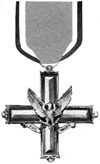
![]() Star indicates a posthumous award.
Star indicates a posthumous award.
* Asterisk denotes those who were killed after their citation.
Private 1st Class Barney Bardman, Distinguished Service Cross, Brooklyn, N. Y.
Private Earl Millsap, Distinguished Service Cross, Asotin, Washington.
Private Albert C. Peterson, Distinguished Service Cross, Stacy, Minnesota.
1st Lieutenant William R. Reid, Distinguished Service Cross, Brooklyn, N. Y.
Major Weston C. Jenkins, Distinguished Service Cross, Rome, New York.
Major Fred A. Tillman, Chevalier, Legion d'Honneur de France, Ulster, Pa.
Captain Everett A. Butterfield, French Order of the Black Star, New York.
![]() Capt. Alexander D. B. Pratt, New York.
Capt. Alexander D. B. Pratt, New York.
![]() 2d Lt. Clarence I. Grubbs, Kansas City, Mo.
2d Lt. Clarence I. Grubbs, Kansas City, Mo.
![]() 2d Lt. Arthur J. Hamblen, New York.
2d Lt. Arthur J. Hamblen, New York.
![]() 2d Lt. F. Hartig, address unknown.
2d Lt. F. Hartig, address unknown.
![]() 2d Lt. Kenneth C. Lincoln, Fall River, Mass.
2d Lt. Kenneth C. Lincoln, Fall River, Mass.
![]() 2d Lt. Harry R. Weiman, St. Louis, Mo.
2d Lt. Harry R. Weiman, St. Louis, Mo.
![]() Sergt. Lloyd C. Anderson, Binghamton, N. Y.
Sergt. Lloyd C. Anderson, Binghamton, N. Y.
![]() Sergt. Charles H. Bradshaw, Brooklyn, N. Y.
Sergt. Charles H. Bradshaw, Brooklyn, N. Y.
![]() Pvt. 1st Class Louis Beckendorf, Brooklyn, N. Y.
Pvt. 1st Class Louis Beckendorf, Brooklyn, N. Y.
*Private Jacob Borker, Brooklyn, N. Y.
![]() Sergt. Ralph U. Brett, New York.
Sergt. Ralph U. Brett, New York.
![]() Pvt. 1st Class George Busko, Breckenridge, Minn.
Pvt. 1st Class George Busko, Breckenridge, Minn.
*Pvt. James Conner, New York.
![]() Corp. Patrick Conway, New York.
Corp. Patrick Conway, New York.
![]() Sergt. Edward M. Crimmins, Binghamton, N. Y.
Sergt. Edward M. Crimmins, Binghamton, N. Y.
![]() Sergt. A. James DiMaggio, Staten Island, N. Y.
Sergt. A. James DiMaggio, Staten Island, N. Y.
![]() Pvt. 1st Class Hugh A. Donnelly, Brooklyn, N. Y.
Pvt. 1st Class Hugh A. Donnelly, Brooklyn, N. Y.
![]() Corp. Edward J. Dwyer, Buffalo, N. Y.
Corp. Edward J. Dwyer, Buffalo, N. Y.
![]() Pvt. William Ehrmann, Brooklyn, N. Y.
Pvt. William Ehrmann, Brooklyn, N. Y.
![]() Sergt. Josiah E. Evans, Ansonia, Conn.
Sergt. Josiah E. Evans, Ansonia, Conn.
![]() Pvt. 1st Class John Greany, New York.
Pvt. 1st Class John Greany, New York.
![]() Pvt. 1st Class P. M. Hagen, Lansford, N. D.
Pvt. 1st Class P. M. Hagen, Lansford, N. D.
![]() Corp. Gilrock Hanson, Creston, Mont.
Corp. Gilrock Hanson, Creston, Mont.
![]() Sergt. William F. Howard, Brooklyn, N. Y.
Sergt. William F. Howard, Brooklyn, N. Y.
![]() Sergt. Ernest C. Hutchings, Manhasset, N. Y.
Sergt. Ernest C. Hutchings, Manhasset, N. Y.
![]() Pvt. 1st Class Robert R. Johnson, Newburgh, N. Y.
Pvt. 1st Class Robert R. Johnson, Newburgh, N. Y.
![]() Pvt. John F. Kelly, Adler, Mont.
Pvt. John F. Kelly, Adler, Mont.
![]() Sergt. George A. Klein, Jr., Brooklyn, N. Y.
Sergt. George A. Klein, Jr., Brooklyn, N. Y.
![]() Sergt. Harvey A. Kreuscher, Staten Island, N. Y.
Sergt. Harvey A. Kreuscher, Staten Island, N. Y.
![]() Pvt. 1st Class James J. Lydon, New York.
Pvt. 1st Class James J. Lydon, New York.
![]() Sergt. Joseph P. Monihan, Wilmington, Del.
Sergt. Joseph P. Monihan, Wilmington, Del.
![]() Pvt. Alfred Nickerson, Lewiston, N. Y.
Pvt. Alfred Nickerson, Lewiston, N. Y.
![]() Pvt. Andrew R. Pucella, Derby, Conn.
Pvt. Andrew R. Pucella, Derby, Conn.
![]() Sergt. John A. Ross, Brooklyn, N. Y.
Sergt. John A. Ross, Brooklyn, N. Y.
![]() Sergt. George F. Russell, Brooklyn, N. Y.
Sergt. George F. Russell, Brooklyn, N. Y.
![]() Pvt. 1st Class Thomas J. Scanlon, New York.
Pvt. 1st Class Thomas J. Scanlon, New York.
![]() Sergt. Aris M. Shellman, New York.
Sergt. Aris M. Shellman, New York.
![]() Pvt. 1st Class Joseph Strauss, New York.
Pvt. 1st Class Joseph Strauss, New York.
![]() Sergt. Monroe Todd, Allen, S. C.
Sergt. Monroe Todd, Allen, S. C.
![]() Pvt. J. Robinson, Newfane, N. Y.
Pvt. J. Robinson, Newfane, N. Y.
![]() Pvt. Volney O. Thompson, Honesdale, Idaho.
Pvt. Volney O. Thompson, Honesdale, Idaho.
![]() Corp. Frederick Viemer, Seymour, Conn.
Corp. Frederick Viemer, Seymour, Conn.
![]() Sergt. Donald M. Wallach, New York.
Sergt. Donald M. Wallach, New York.
 Kelly
KellyThat spirit of dominant Americanism with which the war was fought seems in these times of peace to be best reflected by the American Legion.
Appreciating this, those members of Company B, 307th Infantry, who regarded with favor the idea of a post-bellum organization applied to the American Legion for a charter. One was granted and they were admitted as the Burke-Kelly Post No. 172.
The name was selected in honor of the memory of two of their comrades: Sergeant Frank W. Burke, killed by a high explosive shell on the line of the Vesle, August 23d, 1918, and Corporal John E. Kelly, killed by a high explosive shell during the battle of Merval, September 8th, 1918.
This publication of the History of Company B was made possible by the members of the Burke-Kelly Post under the following officers:
President
William F. Howard
Vice-Presidents
John A. Ross
Arthur J. Hamblen
Alfred Heller
Secretary
A. James DiMaggio
Treasurer
Thomas F. Twyford
Corresponding Secretary
Julius Klausner, Jr.
Executive Committee
Donald M. Wallach
Fred A. Gleiforst
Ralph U. Brett
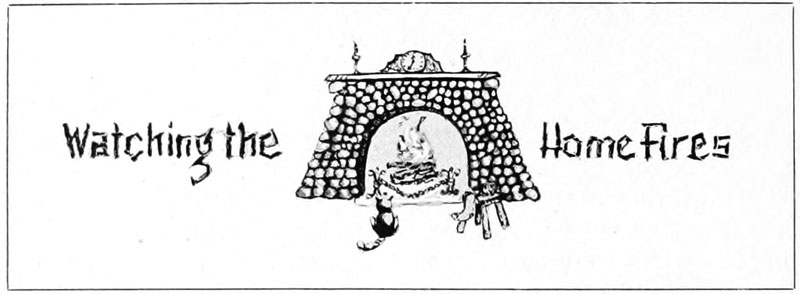
They were watched, and high they burned, by those who more than all else represented to us the concrete reason for which we served.
None of us but felt that we were fighting for our Country; but all of us knew that we were fighting for our Home.
Our Home Folks,—our Mothers and our Fathers, our Sisters and our Wives and our Sweethearts and our Friends—all banded together so that we, while never losing the thought of Home, were also not to lose its touch.
Those tenders of the fireside whom we knew as the "Family Unit" were organized as the Company B Family Unit and were affiliated with the 307th Regimental Family Unit. They formed on our embarkation for overseas, and by virtue of a succession of meetings under the active and enthusiastic leadership of Mrs. William Vanamee and Miss Virginia Fuller they became welded into a body that accomplished immeasurable benefit not only for our physical but also for our spiritual welfare.
The socks, the cigarettes, the wristlets and the soap were needs of vast import, but our knowledge that those behind us were marshaled just as we were was more warming than wristlets, more comforting than cigarettes.
The officers during the early period were Miss Virginia Fuller, President; Miss Helen Pritchard, Secretary; Mrs. W. B. Wise, Treasurer. The meetings were held in a barren loft at 6 East 30th Street, New York City. Here the ideas were conceived, the plans formulated, and the policies acted upon, that were so far-reaching and effective.
Tho first drawn together for the good of Company B, their own sufferings served to consolidate their interests and to strengthen their purpose.
As notice after notice issued from Washington advising as to losses in battle by death and by wounds, the need for common consolation became most urgent and a noble response came from those who were in a position to give comfort. These were trying days, days of mental agony, days of longing and hoping and praying.[Pg 31]
In September one of our own men, Sergeant George A. Klein, Jr., who had been returned to the United States as an instructor, appeared at a meeting and gave word, mostly welcome, some sad, to the news-hungry relatives.
These various activities were recorded in a small four-page bulletin published for and distributed to us overseas.
And then the Armistice. Relief from the tension of the meetings was given by the final let-up of the war and soon the time came when much thought was given to filling those "9x4x3" boxes of Christmas cheer.
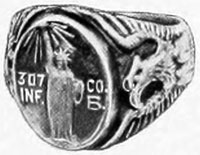 The Ring
The Ring
The date of our return was flashed across the waters during the early part of April and immediately wheels were set in motion to prepare for it.
Their welcome took the form of a reception and dance. For the first time, and the only time, Company B and the Family Unit were together. And as a token of their affection and regard they presented to each of us a silver signet ring bearing our Divisional insignia—Liberty, together with the Company and Regimental designation. Inside the ring they had placed as their wish: "May God Protect You."
Guests of especial honor were the two McIntyre sisters, who were so active overseas with the Salvation Army and who for so long a time had been identified with our Division, having for a while been assigned to our own Regiment.
Thus culminated the activities of the Family Unit of Company B. But just as we have decided upon a continuation of our organization—the same in substance, if not in form,—so the Unit decided to serve as the Auxiliary to the Burke-Kelly Post, American Legion.
The Auxiliary meetings are held in the rooms adjoining those of the Burke-Kelly Post, at the 77th Division Club. The original board of officers includes Mrs. A. J. Hamblen, President; Miss Virginia Fuller, Miss Sarah Kelly, and Mrs. William Charles, Vice-Presidents; Miss Anna Charles, Secretary, and Mrs. W. B. Wise, Treasurer.
And their banner is still held aloft. A new name, but the old purpose.
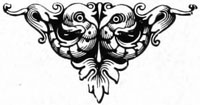
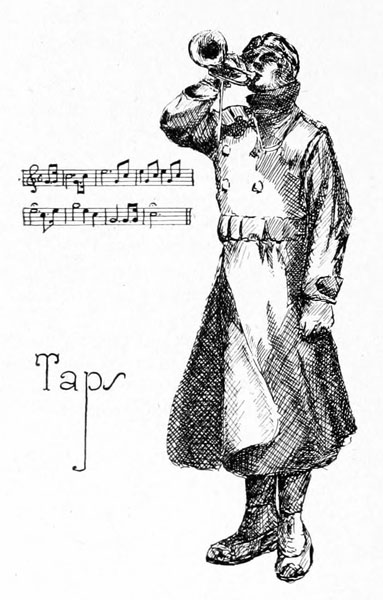
End of Project Gutenberg's Company B, 307th Infantry, by Julius Klausner
*** END OF THIS PROJECT GUTENBERG EBOOK COMPANY B, 307TH INFANTRY ***
***** This file should be named 33932-h.htm or 33932-h.zip *****
This and all associated files of various formats will be found in:
http://www.gutenberg.org/3/3/9/3/33932/
Produced by Patrick Hopkins and the Online Distributed
Proofreading Team at http://www.pgdp.net (This file was
produced from images generously made available by The
Internet Archive/American Libraries.)
Updated editions will replace the previous one--the old editions
will be renamed.
Creating the works from public domain print editions means that no
one owns a United States copyright in these works, so the Foundation
(and you!) can copy and distribute it in the United States without
permission and without paying copyright royalties. Special rules,
set forth in the General Terms of Use part of this license, apply to
copying and distributing Project Gutenberg-tm electronic works to
protect the PROJECT GUTENBERG-tm concept and trademark. Project
Gutenberg is a registered trademark, and may not be used if you
charge for the eBooks, unless you receive specific permission. If you
do not charge anything for copies of this eBook, complying with the
rules is very easy. You may use this eBook for nearly any purpose
such as creation of derivative works, reports, performances and
research. They may be modified and printed and given away--you may do
practically ANYTHING with public domain eBooks. Redistribution is
subject to the trademark license, especially commercial
redistribution.
*** START: FULL LICENSE ***
THE FULL PROJECT GUTENBERG LICENSE
PLEASE READ THIS BEFORE YOU DISTRIBUTE OR USE THIS WORK
To protect the Project Gutenberg-tm mission of promoting the free
distribution of electronic works, by using or distributing this work
(or any other work associated in any way with the phrase "Project
Gutenberg"), you agree to comply with all the terms of the Full Project
Gutenberg-tm License (available with this file or online at
http://gutenberg.org/license).
Section 1. General Terms of Use and Redistributing Project Gutenberg-tm
electronic works
1.A. By reading or using any part of this Project Gutenberg-tm
electronic work, you indicate that you have read, understand, agree to
and accept all the terms of this license and intellectual property
(trademark/copyright) agreement. If you do not agree to abide by all
the terms of this agreement, you must cease using and return or destroy
all copies of Project Gutenberg-tm electronic works in your possession.
If you paid a fee for obtaining a copy of or access to a Project
Gutenberg-tm electronic work and you do not agree to be bound by the
terms of this agreement, you may obtain a refund from the person or
entity to whom you paid the fee as set forth in paragraph 1.E.8.
1.B. "Project Gutenberg" is a registered trademark. It may only be
used on or associated in any way with an electronic work by people who
agree to be bound by the terms of this agreement. There are a few
things that you can do with most Project Gutenberg-tm electronic works
even without complying with the full terms of this agreement. See
paragraph 1.C below. There are a lot of things you can do with Project
Gutenberg-tm electronic works if you follow the terms of this agreement
and help preserve free future access to Project Gutenberg-tm electronic
works. See paragraph 1.E below.
1.C. The Project Gutenberg Literary Archive Foundation ("the Foundation"
or PGLAF), owns a compilation copyright in the collection of Project
Gutenberg-tm electronic works. Nearly all the individual works in the
collection are in the public domain in the United States. If an
individual work is in the public domain in the United States and you are
located in the United States, we do not claim a right to prevent you from
copying, distributing, performing, displaying or creating derivative
works based on the work as long as all references to Project Gutenberg
are removed. Of course, we hope that you will support the Project
Gutenberg-tm mission of promoting free access to electronic works by
freely sharing Project Gutenberg-tm works in compliance with the terms of
this agreement for keeping the Project Gutenberg-tm name associated with
the work. You can easily comply with the terms of this agreement by
keeping this work in the same format with its attached full Project
Gutenberg-tm License when you share it without charge with others.
1.D. The copyright laws of the place where you are located also govern
what you can do with this work. Copyright laws in most countries are in
a constant state of change. If you are outside the United States, check
the laws of your country in addition to the terms of this agreement
before downloading, copying, displaying, performing, distributing or
creating derivative works based on this work or any other Project
Gutenberg-tm work. The Foundation makes no representations concerning
the copyright status of any work in any country outside the United
States.
1.E. Unless you have removed all references to Project Gutenberg:
1.E.1. The following sentence, with active links to, or other immediate
access to, the full Project Gutenberg-tm License must appear prominently
whenever any copy of a Project Gutenberg-tm work (any work on which the
phrase "Project Gutenberg" appears, or with which the phrase "Project
Gutenberg" is associated) is accessed, displayed, performed, viewed,
copied or distributed:
This eBook is for the use of anyone anywhere at no cost and with
almost no restrictions whatsoever. You may copy it, give it away or
re-use it under the terms of the Project Gutenberg License included
with this eBook or online at www.gutenberg.org
1.E.2. If an individual Project Gutenberg-tm electronic work is derived
from the public domain (does not contain a notice indicating that it is
posted with permission of the copyright holder), the work can be copied
and distributed to anyone in the United States without paying any fees
or charges. If you are redistributing or providing access to a work
with the phrase "Project Gutenberg" associated with or appearing on the
work, you must comply either with the requirements of paragraphs 1.E.1
through 1.E.7 or obtain permission for the use of the work and the
Project Gutenberg-tm trademark as set forth in paragraphs 1.E.8 or
1.E.9.
1.E.3. If an individual Project Gutenberg-tm electronic work is posted
with the permission of the copyright holder, your use and distribution
must comply with both paragraphs 1.E.1 through 1.E.7 and any additional
terms imposed by the copyright holder. Additional terms will be linked
to the Project Gutenberg-tm License for all works posted with the
permission of the copyright holder found at the beginning of this work.
1.E.4. Do not unlink or detach or remove the full Project Gutenberg-tm
License terms from this work, or any files containing a part of this
work or any other work associated with Project Gutenberg-tm.
1.E.5. Do not copy, display, perform, distribute or redistribute this
electronic work, or any part of this electronic work, without
prominently displaying the sentence set forth in paragraph 1.E.1 with
active links or immediate access to the full terms of the Project
Gutenberg-tm License.
1.E.6. You may convert to and distribute this work in any binary,
compressed, marked up, nonproprietary or proprietary form, including any
word processing or hypertext form. However, if you provide access to or
distribute copies of a Project Gutenberg-tm work in a format other than
"Plain Vanilla ASCII" or other format used in the official version
posted on the official Project Gutenberg-tm web site (www.gutenberg.org),
you must, at no additional cost, fee or expense to the user, provide a
copy, a means of exporting a copy, or a means of obtaining a copy upon
request, of the work in its original "Plain Vanilla ASCII" or other
form. Any alternate format must include the full Project Gutenberg-tm
License as specified in paragraph 1.E.1.
1.E.7. Do not charge a fee for access to, viewing, displaying,
performing, copying or distributing any Project Gutenberg-tm works
unless you comply with paragraph 1.E.8 or 1.E.9.
1.E.8. You may charge a reasonable fee for copies of or providing
access to or distributing Project Gutenberg-tm electronic works provided
that
- You pay a royalty fee of 20% of the gross profits you derive from
the use of Project Gutenberg-tm works calculated using the method
you already use to calculate your applicable taxes. The fee is
owed to the owner of the Project Gutenberg-tm trademark, but he
has agreed to donate royalties under this paragraph to the
Project Gutenberg Literary Archive Foundation. Royalty payments
must be paid within 60 days following each date on which you
prepare (or are legally required to prepare) your periodic tax
returns. Royalty payments should be clearly marked as such and
sent to the Project Gutenberg Literary Archive Foundation at the
address specified in Section 4, "Information about donations to
the Project Gutenberg Literary Archive Foundation."
- You provide a full refund of any money paid by a user who notifies
you in writing (or by e-mail) within 30 days of receipt that s/he
does not agree to the terms of the full Project Gutenberg-tm
License. You must require such a user to return or
destroy all copies of the works possessed in a physical medium
and discontinue all use of and all access to other copies of
Project Gutenberg-tm works.
- You provide, in accordance with paragraph 1.F.3, a full refund of any
money paid for a work or a replacement copy, if a defect in the
electronic work is discovered and reported to you within 90 days
of receipt of the work.
- You comply with all other terms of this agreement for free
distribution of Project Gutenberg-tm works.
1.E.9. If you wish to charge a fee or distribute a Project Gutenberg-tm
electronic work or group of works on different terms than are set
forth in this agreement, you must obtain permission in writing from
both the Project Gutenberg Literary Archive Foundation and Michael
Hart, the owner of the Project Gutenberg-tm trademark. Contact the
Foundation as set forth in Section 3 below.
1.F.
1.F.1. Project Gutenberg volunteers and employees expend considerable
effort to identify, do copyright research on, transcribe and proofread
public domain works in creating the Project Gutenberg-tm
collection. Despite these efforts, Project Gutenberg-tm electronic
works, and the medium on which they may be stored, may contain
"Defects," such as, but not limited to, incomplete, inaccurate or
corrupt data, transcription errors, a copyright or other intellectual
property infringement, a defective or damaged disk or other medium, a
computer virus, or computer codes that damage or cannot be read by
your equipment.
1.F.2. LIMITED WARRANTY, DISCLAIMER OF DAMAGES - Except for the "Right
of Replacement or Refund" described in paragraph 1.F.3, the Project
Gutenberg Literary Archive Foundation, the owner of the Project
Gutenberg-tm trademark, and any other party distributing a Project
Gutenberg-tm electronic work under this agreement, disclaim all
liability to you for damages, costs and expenses, including legal
fees. YOU AGREE THAT YOU HAVE NO REMEDIES FOR NEGLIGENCE, STRICT
LIABILITY, BREACH OF WARRANTY OR BREACH OF CONTRACT EXCEPT THOSE
PROVIDED IN PARAGRAPH 1.F.3. YOU AGREE THAT THE FOUNDATION, THE
TRADEMARK OWNER, AND ANY DISTRIBUTOR UNDER THIS AGREEMENT WILL NOT BE
LIABLE TO YOU FOR ACTUAL, DIRECT, INDIRECT, CONSEQUENTIAL, PUNITIVE OR
INCIDENTAL DAMAGES EVEN IF YOU GIVE NOTICE OF THE POSSIBILITY OF SUCH
DAMAGE.
1.F.3. LIMITED RIGHT OF REPLACEMENT OR REFUND - If you discover a
defect in this electronic work within 90 days of receiving it, you can
receive a refund of the money (if any) you paid for it by sending a
written explanation to the person you received the work from. If you
received the work on a physical medium, you must return the medium with
your written explanation. The person or entity that provided you with
the defective work may elect to provide a replacement copy in lieu of a
refund. If you received the work electronically, the person or entity
providing it to you may choose to give you a second opportunity to
receive the work electronically in lieu of a refund. If the second copy
is also defective, you may demand a refund in writing without further
opportunities to fix the problem.
1.F.4. Except for the limited right of replacement or refund set forth
in paragraph 1.F.3, this work is provided to you 'AS-IS' WITH NO OTHER
WARRANTIES OF ANY KIND, EXPRESS OR IMPLIED, INCLUDING BUT NOT LIMITED TO
WARRANTIES OF MERCHANTIBILITY OR FITNESS FOR ANY PURPOSE.
1.F.5. Some states do not allow disclaimers of certain implied
warranties or the exclusion or limitation of certain types of damages.
If any disclaimer or limitation set forth in this agreement violates the
law of the state applicable to this agreement, the agreement shall be
interpreted to make the maximum disclaimer or limitation permitted by
the applicable state law. The invalidity or unenforceability of any
provision of this agreement shall not void the remaining provisions.
1.F.6. INDEMNITY - You agree to indemnify and hold the Foundation, the
trademark owner, any agent or employee of the Foundation, anyone
providing copies of Project Gutenberg-tm electronic works in accordance
with this agreement, and any volunteers associated with the production,
promotion and distribution of Project Gutenberg-tm electronic works,
harmless from all liability, costs and expenses, including legal fees,
that arise directly or indirectly from any of the following which you do
or cause to occur: (a) distribution of this or any Project Gutenberg-tm
work, (b) alteration, modification, or additions or deletions to any
Project Gutenberg-tm work, and (c) any Defect you cause.
Section 2. Information about the Mission of Project Gutenberg-tm
Project Gutenberg-tm is synonymous with the free distribution of
electronic works in formats readable by the widest variety of computers
including obsolete, old, middle-aged and new computers. It exists
because of the efforts of hundreds of volunteers and donations from
people in all walks of life.
Volunteers and financial support to provide volunteers with the
assistance they need, are critical to reaching Project Gutenberg-tm's
goals and ensuring that the Project Gutenberg-tm collection will
remain freely available for generations to come. In 2001, the Project
Gutenberg Literary Archive Foundation was created to provide a secure
and permanent future for Project Gutenberg-tm and future generations.
To learn more about the Project Gutenberg Literary Archive Foundation
and how your efforts and donations can help, see Sections 3 and 4
and the Foundation web page at http://www.pglaf.org.
Section 3. Information about the Project Gutenberg Literary Archive
Foundation
The Project Gutenberg Literary Archive Foundation is a non profit
501(c)(3) educational corporation organized under the laws of the
state of Mississippi and granted tax exempt status by the Internal
Revenue Service. The Foundation's EIN or federal tax identification
number is 64-6221541. Its 501(c)(3) letter is posted at
http://pglaf.org/fundraising. Contributions to the Project Gutenberg
Literary Archive Foundation are tax deductible to the full extent
permitted by U.S. federal laws and your state's laws.
The Foundation's principal office is located at 4557 Melan Dr. S.
Fairbanks, AK, 99712., but its volunteers and employees are scattered
throughout numerous locations. Its business office is located at
809 North 1500 West, Salt Lake City, UT 84116, (801) 596-1887, email
business@pglaf.org. Email contact links and up to date contact
information can be found at the Foundation's web site and official
page at http://pglaf.org
For additional contact information:
Dr. Gregory B. Newby
Chief Executive and Director
gbnewby@pglaf.org
Section 4. Information about Donations to the Project Gutenberg
Literary Archive Foundation
Project Gutenberg-tm depends upon and cannot survive without wide
spread public support and donations to carry out its mission of
increasing the number of public domain and licensed works that can be
freely distributed in machine readable form accessible by the widest
array of equipment including outdated equipment. Many small donations
($1 to $5,000) are particularly important to maintaining tax exempt
status with the IRS.
The Foundation is committed to complying with the laws regulating
charities and charitable donations in all 50 states of the United
States. Compliance requirements are not uniform and it takes a
considerable effort, much paperwork and many fees to meet and keep up
with these requirements. We do not solicit donations in locations
where we have not received written confirmation of compliance. To
SEND DONATIONS or determine the status of compliance for any
particular state visit http://pglaf.org
While we cannot and do not solicit contributions from states where we
have not met the solicitation requirements, we know of no prohibition
against accepting unsolicited donations from donors in such states who
approach us with offers to donate.
International donations are gratefully accepted, but we cannot make
any statements concerning tax treatment of donations received from
outside the United States. U.S. laws alone swamp our small staff.
Please check the Project Gutenberg Web pages for current donation
methods and addresses. Donations are accepted in a number of other
ways including checks, online payments and credit card donations.
To donate, please visit: http://pglaf.org/donate
Section 5. General Information About Project Gutenberg-tm electronic
works.
Professor Michael S. Hart is the originator of the Project Gutenberg-tm
concept of a library of electronic works that could be freely shared
with anyone. For thirty years, he produced and distributed Project
Gutenberg-tm eBooks with only a loose network of volunteer support.
Project Gutenberg-tm eBooks are often created from several printed
editions, all of which are confirmed as Public Domain in the U.S.
unless a copyright notice is included. Thus, we do not necessarily
keep eBooks in compliance with any particular paper edition.
Most people start at our Web site which has the main PG search facility:
http://www.gutenberg.org
This Web site includes information about Project Gutenberg-tm,
including how to make donations to the Project Gutenberg Literary
Archive Foundation, how to help produce our new eBooks, and how to
subscribe to our email newsletter to hear about new eBooks.